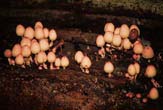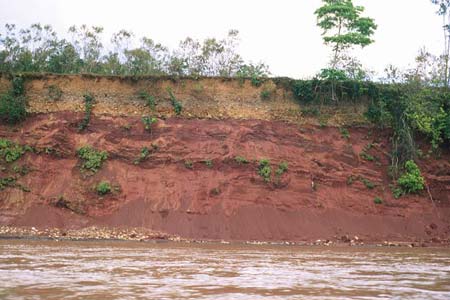Why brown land?

Mushrooms are decomposing a woody stem in the Amazon rainforest in Peru.( Photo: LiveScience )
From the universe, the earth looks cool with green and blue. But if you keep your eyes close to the ground, you might just see brown. Where is this color? It is from green plants, A new study revealed.
When plants wilt and die, their leaves and branches fall, carrying the carbon they have stored in the soil.
Tiny microbes on the earth bitten these plant residues with specialized enzymes (which break down the bonds in leaves and stems) to create good prey for their size. . Hungry microorganisms handle a large amount of carbon in the soil, even collecting several types of elements into their cells.
And because of such busyness, the bacteria cannot complete the job. " They're not hundred percent efficient crushers ," said Steven Allison, an ecologist at Irvine University, California.

Slice the soil along the Manu River, Perru is yellowish and red in color due to minerals, while the thin layer on the surface is brown due to the presence of organic carbon.( Photo: LiveScience )
" There are pieces of carbon that are not eaten by bacteria, and have carbon in their own bodies. Then they die, carbon returns to the earth. It is a cycle in which there is always carbon remaining. These small pieces accumulate over time . "
They are called humus materials, piled up year after year. The storehouse of bacteria that accumulates the carbon has made the earth brown, because carbon absorbs most of the color in the sun's spectrum, except that the brown light is reflected back by it.
However, not all land around the earth is brown. Some deserts seem to have only white sand. Hawaiian soil, rich in iron, is reddish. Dig deep into the ground in some dirty brown areas, you will see other colors below.
" Without too much carbon in the ground, the ground will be yellow, red and gray. They depend on the color of the main mineral there ," Allison said.
T. An
- Amazingly explore the mysterious nature of brown dwarfs
- Brown bear in the fishing season
- The Earth is about to lose 1/3 of its food land
- 9 great effects of brown rice
- Discovering the secret of life in brown dwarfs
- Shiver the second world snake venom to stand up with tail chasing people
- Discover the astonishment of the planet's formation
- The world's longest brown bear died at the age of 35
- Smoke brown covered the sky, people panicked aliens attack
- Discover a new type of fat in humans
- Brown bear in Austria for the second time was declared extinct
- Animals are also addicted to 'relationships' by mouth
 Is the magnetic North Pole shift dangerous to humanity?
Is the magnetic North Pole shift dangerous to humanity? Washington legalizes the recycling of human bodies into fertilizer
Washington legalizes the recycling of human bodies into fertilizer Lightning stone - the mysterious guest
Lightning stone - the mysterious guest Stunned by the mysterious sunset, strange appearance
Stunned by the mysterious sunset, strange appearance